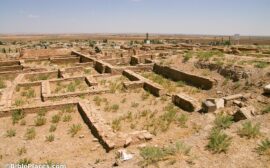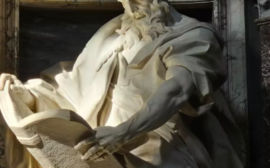By: Scott Reynolds, Ph.D., D.Min. | May 28, 2023
The Roman cross as a fatal punishment has not been doubted as a historical fact by most scholars, whether religious or not; the concept of crucifixion is accepted without push back from scholars or the general public.
Origins of Crucifixion, the Bone, and the Ossuary
Archaeology reveals that crucifixion probably began with the Phoenicians (around the tenth century BC), was adopted by the Assyrians as a form of torture known as impaling (see the Lachish relief), but was most perfected by the Romans, who chose it as a method of execution for state criminals. Both the army of Spartacus, as well as some 800 Pharisees, were recorded put to death in Jerusalem by crucifixion. Yet despite widespread references to its practice in ancient literature such as the Dead Sea Scrolls, the writings of Josephus, the Talmud, various Roman annals, and the New Testament, no material evidence of a crucified victim had ever been found in the Holy Land until 1968. It was then that the remains of a crucified man from Giv’at ha-Mivtar, a northern suburb of Jerusalem, were discovered in an ossuary from near the time of Jesus.[1]
The important artifact demonstrating the cruelty of crucifixion was an ankle bone still pierced with a seven-inch-long nail and attached to a piece of wood. The significance of this artifact makes it one of the most important archaeological finds capable of shedding true historical light on Jesus’s crucifixion as recorded in the Bible.
Surprising Insight that a Crucified Bone was Found in an Ossuary
The second key element is the fact that it was found at all. Skeptics have claimed that all crucified bodies were thrown into a common grave and not given the dignity of a proper burial. However, the discovery of the crucified bones in an ossuary puts that theory to rest. Here a family was allowed to take back the body and place it in a family tomb to perform all of the traditional rites that accompanied the dead during Jewish history. The ossuary is vital to the validity of Jesus being taken by some of his disciples and placed in Joseph of Arimathea’s tomb (Matthew 27:60), where he was given a traditional burial.
After this, Joseph of Arimathea, who was a disciple of Jesus—but secretly because of his fear of the Jews—asked Pilate that he might remove Jesus’s body. Pilate gave him permission; so he came and took his body away. 39 Nicodemus (who had previously come to him at night) also came, bringing a mixture of about seventy-five pounds of myrrh and aloes. 40 They took Jesus’s body and wrapped it in linen cloths with the fragrant spices, according to the burial custom of the Jews. 41 There was a garden in the place where he was crucified. A new tomb was in the garden; no one had yet been placed in it. 42 They placed Jesus there because of the Jewish day of preparation and since the tomb was nearby (John 19:38–42).
The Evidence the Crucified Bone and Ossuary Provide for John’s Account
The crucified foot discovered through a proper burial gives weight to John’s account of the burial of Jesus. Those crucified with the means to have a proper burial were given that opportunity. Here, archaeology has proven the common grave theory to be false. Jesus had disciples with the means to request his body and provide a traditional Jewish burial.
Apologetically, when skeptics and critical scholars address the resurrection, they speak of different theories such as the disciples stealing the body, the swoon theory, and the common grave theory. Jesus was not in the grave because he had been thrown into a common grave and buried with the common criminals. However, the crucified feet found in an ossuary set a precedent for the bodies of crucified victims to be given back to family and friends if requested. Jesus would not have been thrown into a common grave for this reason.
There was a good and righteous man named Joseph, a member of the Sanhedrin, 51 who had not agreed with their plan and action. He was from Arimathea, a Judean town, and was looking forward to the kingdom of God. 52 He approached Pilate and asked for Jesus’s body. 53 Taking it down, he wrapped it in fine linen and placed it in a tomb cut into the rock, where no one had ever been placed., 54 It was the preparation day, and the Sabbath was about to begin. 55 The women who had come with him from Galilee followed along and observed the tomb and how his body was placed. 56 Then they returned and prepared spices and perfumes. And they rested on the Sabbath according to the commandment (Luke 23:50–56).
Conclusion of the Crucified Bone and Ossuary
There were family and followers with the influence and means to properly bury the body and place Jesus’s body through the steps of a proper Jewish burial. The crucified foot is an instrumental archaeological artifact capable of debunking theories contrary to the biblical account of the burial of Jesus. The results give an apologist the ability to avoid getting stuck in a debate on the burial and to move directly to defending the resurrection of Jesus from the tomb.
About the Author

Dr. Scott Reynolds earned his Ph.D. in Theology and Apologetics from Liberty University and his D.Min from New Orleans Baptist Theological Seminary. In addition to his doctoral accomplishments, he earned degrees from Troy University. Dr. Reynolds has traveled the world and has served as an archaeologist with some of the biggest names in the field. He brings a passion for biblical studies, biblical history, and an expertise in archaeological studies. Dr. Reynolds is a retired pastor and church planter. He has taught at New Orleans Baptist Theological Seminary and now is now working archaeological digs in a pursuit of discovering the apologetic properties of archaeology. Scott and his wife Lori have two grown children, one granddaughter and a very spoiled dog.
Notes
[1] Holden and Geisler, The Popular Handbook of Archaeology and the Bible., 308-309.
If you enjoyed this article, consider reading this article by the same author. https://bellatorchristi.com/2022/05/15/what-words-tell-us-about-culture/
Copyright, 2023. Bellator Christi.





